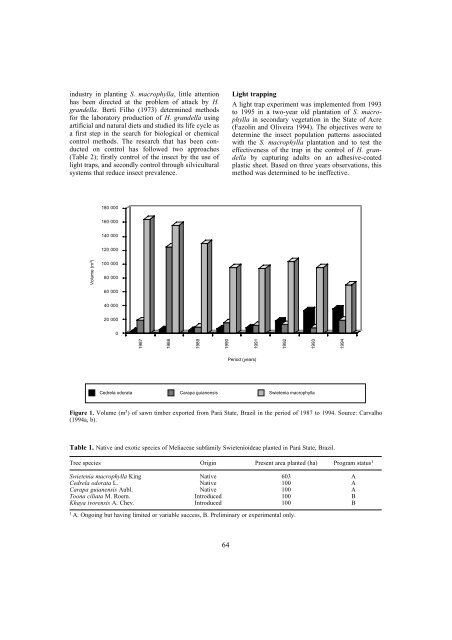Hypsipyla Shoot Borers of Meliaceae in Sri Lanka - Australian ...
Hypsipyla Shoot Borers of Meliaceae in Sri Lanka - Australian ...
Hypsipyla Shoot Borers of Meliaceae in Sri Lanka - Australian ...
Create successful ePaper yourself
Turn your PDF publications into a flip-book with our unique Google optimized e-Paper software.
<strong>in</strong>dustry <strong>in</strong> plant<strong>in</strong>g S. macrophylla, little attention<br />
has been directed at the problem <strong>of</strong> attack by H.<br />
grandella. Berti Filho (1973) determ<strong>in</strong>ed methods<br />
for the laboratory production <strong>of</strong> H. grandella us<strong>in</strong>g<br />
artificial and natural diets and studied its life cycle as<br />
a first step <strong>in</strong> the search for biological or chemical<br />
control methods. The research that has been conducted<br />
on control has followed two approaches<br />
(Table 2); firstly control <strong>of</strong> the <strong>in</strong>sect by the use <strong>of</strong><br />
light traps, and secondly control through silvicultural<br />
systems that reduce <strong>in</strong>sect prevalence.<br />
Volume (m 3 )<br />
180 000<br />
160 000<br />
140 000<br />
120 000<br />
100 000<br />
80 000<br />
60 000<br />
40 000<br />
20 000<br />
0<br />
1987<br />
1988<br />
64<br />
Light trapp<strong>in</strong>g<br />
A light trap experiment was implemented from 1993<br />
to 1995 <strong>in</strong> a two-year old plantation <strong>of</strong> S. macrophylla<br />
<strong>in</strong> secondary vegetation <strong>in</strong> the State <strong>of</strong> Acre<br />
(Fazol<strong>in</strong> and Oliveira 1994). The objectives were to<br />
determ<strong>in</strong>e the <strong>in</strong>sect population patterns associated<br />
with the S. macrophylla plantation and to test the<br />
effectiveness <strong>of</strong> the trap <strong>in</strong> the control <strong>of</strong> H. grandella<br />
by captur<strong>in</strong>g adults on an adhesive-coated<br />
plastic sheet. Based on three years observations, this<br />
method was determ<strong>in</strong>ed to be <strong>in</strong>effective.<br />
Figure 1. Volume (m 3 ) <strong>of</strong> sawn timber exported from Pará State, Brazil <strong>in</strong> the period <strong>of</strong> 1987 to 1994. Source: Carvalho<br />
(1994a, b).<br />
Table 1. Native and exotic species <strong>of</strong> <strong>Meliaceae</strong> subfamily Swietenioideae planted <strong>in</strong> Pará State, Brazil.<br />
Tree species Orig<strong>in</strong> Present area planted (ha) Program status 1<br />
Swietenia macrophylla K<strong>in</strong>g Native 603 A<br />
Cedrela odorata L. Native 100 A<br />
Carapa guianensis Aubl. Native 100 A<br />
Toona ciliata M. Roem. Introduced 100 B<br />
Khaya ivorensis A. Chev. Introduced 100 B<br />
1 A. Ongo<strong>in</strong>g but hav<strong>in</strong>g limited or variable success, B. Prelim<strong>in</strong>ary or experimental only.<br />
1989<br />
1990<br />
1991<br />
Period (years)<br />
Cedrela odorata Carapa guianensis Swietenia macrophylla<br />
1992<br />
1993<br />
1994

















